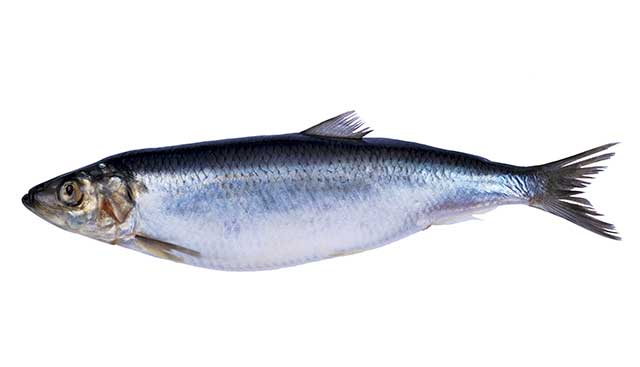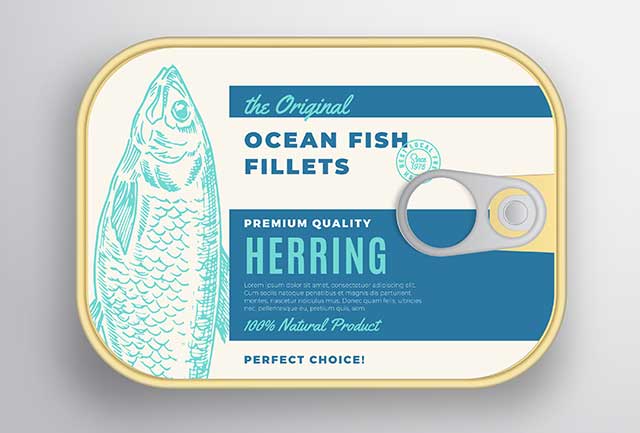Herring is a healthy, affordable and delicious type of oily fish that is packed with nutrients.
This small silver-colored fish primarily lives near coastal regions of the Atlantic and Pacific ocean.
Herring is particularly beneficial for its omega-3 content, and it offers one of the most concentrated sources of the fatty acid.
In this article, we will examine the potential health benefits of herring and take a look at its full nutrition profile.
1) Herring Is Very High In Omega-3 Fatty Acids
Omega-3 fatty acids have anti-inflammatory properties, and oily fish consumption has been shown to (1, 2, 3);
- Lower triglyceride levels
- Decrease levels of VLDL (very low-density lipoprotein)
- Increase HDL levels
All of these changes are thought to lower the risk of cardiovascular events (4, 5, 6).
The Dietary Guidelines for Americans 2015-2020 recommend at least 250 mg of EPA/DHA omega-3 fatty acids per day (7).
EPA and DHA are the most bioavailable form of omega-3, and they are found primarily in seafood such as oily fish.
However, the average consumption of EPA and DHA omega-3 in the United States is less than one-third of this amount (8).
On the positive side, herring is an excellent source of omega-3, and a standard herring fillet provides 3181 mg of omega-3 (9).
For another omega-3 rich fish, see this guide to anchovies.
2) Herring Contains Various Antioxidants
Most people think of things like green tea and red wine when they hear the word “antioxidants.”
However, two of the most potent antioxidants are essential nutrients, namely vitamin E and selenium.
Both of these nutrients play an important role in the immune system, and they help to minimize the damage caused by free radicals to body tissues (10, 11).
Per 184 g fillet, herring provides 96% and 10% of the RDI for selenium and vitamin E respectively (9).
3) Herring Provides a Substantial Amount of Vitamin D
It is common knowledge that (safe) sun exposure is the best source of vitamin D.
However, there are also some excellent food sources of vitamin D3, and herring is among the very best.
To illustrate this; just one fillet of herring provides 307 IU of vitamin D, which is equivalent to 76.8% of the RDI (9).
Unfortunately, a lot of people struggle to obtain sufficient levels of vitamin D.
For example, 39.4% of the UK population, which has a cold and dark winter, has vitamin D deficiency during the winter months (10).
Additionally, vitamin D is prevalent around the world for people of all ages (11).
For these reasons, herring could be an excellent choice of food for those who live in parts of the world with limited sunlight hours.
Vitamin D has numerous vital roles in the human body, and research suggests that it may lower the risk of serious diseases such as cancer and cardiovascular disease (12).
4) Rich In Protein
Herring is protein-rich, and a regular 184-gram fillet offers 33 grams of high-quality protein (9).
As a complete source of protein, herring provides all the essential amino acids in sufficient amounts.
Additionally, since herring only contains around 291 calories per fillet, it is a relatively low-calorie and thereby protein-dense food.
5) Herring Has Low Levels of Mercury
Although seafood as a food group is very nutritious, some popular species (such as swordfish) contain large amounts of mercury.
Mercury is a toxic heavy metal that can cause a wide range of adverse health effects in the body, and it is toxic to the major organs (13).
Fortunately, another benefit of herring is that it is one of the cleanest ocean fish, and it contains minimal amounts of mercury.
For example, research from the FDA demonstrates that herring has a mean mercury concentration (PPM) of 0.078 (14).
Compared to fish species such as shark (0.979 PPM), swordfish (0.995 PPM) and albacore tuna (0.358 PPM), this is very low.
6) May Increase Nitric Oxide Production (Which Lowers Blood Pressure)
One recent study suggests that herring has the effect of increasing nitric oxide production (15).
This randomized trial randomly assigned male participants to either a “herring diet” of five meals per week of herring for four weeks or to a “chicken diet” with the same schedule.
The men on the herring diet showed an increase of nitric oxide in the blood compared to men on the chicken diet. Higher blood concentrations of nitric oxide tend to lower blood pressure (16, 17).
However, since this was only a small study (15 participants), further research is necessary.
Unfortunately, herring is not one of the more popular areas of nutrition research, and there are little further studies in this area.
7) Incredibly Rich In Vitamin B12
Herring contains large concentrations of vitamin B12.
Per 184-gram fillet, herring provides 419% of the RDI for the vitamin (9).
In addition, herring contains a good amount of the other B vitamins, all of which play an essential role in energy metabolism (18).
Vitamin B12 is one of the world’s most common nutrient deficiencies, particularly in older adults.
On this note, research shows that up to 38% of older adults may exhibit mild signs of deficiency (19).
Since just one fillet of herring contains so much vitamin B12, it is an excellent dietary option for those at risk of deficiency.
8) Herring Is Very Nutrient-Dense
Herring contains large concentrations of nutrients for very few calories, which makes it a very nutrient-dense food.
For example, herring supplies every essential nutrient (in varying proportions).
This oily fish also offers many multiples of the RDI for vitamin B12 and vitamin D per 100 grams – all for only 158 calories (9).
When you consider that herring is also an excellent source of omega-3, it is challenging to get this combination of nutrients from other food.
In short; herring is a great source of nutrition.
9) Herring Is Affordable, and It Tastes Great
Lastly, while not technically a “health benefit,” herring also offers excellent value-for-money.
It is very cheap and easily affordable, and you can buy it in numerous different varieties whether fresh, pickled, smoked, or canned.
Herring is also a tasty fish; it is very flavorful, and it has a soft, tender flesh thanks to its high concentration of fat.
Food being healthy and nutritious isn’t always enough if nobody wants to eat it, but herring is an enjoyable food to eat.
Nutrition Facts
Now that we have looked at some of the health benefits of herring, here is the full nutrition profile for reference purposes.
The following data shows the full nutritional values for herring per 100 grams (raw) sourced from the USDA Food Composition Databases (9).
Calories and Macronutrients
| Calories/Nutrient | Amount (kcal/grams) |
|---|---|
| Calories | 158 kcal |
| Carbohydrate | 0 g |
| Fat | 9.0 g |
| Saturated Fat | 2.0 g |
| Monounsaturated Fat | 3.7 g |
| Polyunsaturated Fat | 2.1 g |
| Omega-3 | 1729 mg |
| Omega-6 | 130 mg |
| Protein | 18.0 g |
Vitamins
| Vitamin | Amount | % RDI |
|---|---|---|
| Vitamin D | 167 IU | 41.8 % |
| Vitamin B12 | 13.7 mcg | 228 % |
| Vitamin B3 | 3.2 mg | 16 % |
| Vitamin B6 | 0.3 mg | 15 % |
| Vitamin B2 | 0.2 mg | 14 % |
| Vitamin B1 | 0.1 mg | 6 % |
| Vitamin B5 | 0.1 mg | 6 % |
| Vitamin E | 1.1 mg | 5 % |
| Vitamin A | 93.0 IU | 2 % |
| Folate | 10.0 mcg | 2 % |
| Vitamin C | 0.7 mg | 1 % |
Herring also contains a source of vitamin K2 (menaquinone 4), but the USDA does not publish the data for this.
Minerals
| Mineral | Amount | % RDI |
|---|---|---|
| Selenium | 36.5 mcg | 52 % |
| Phosphorus | 236 mg | 24 % |
| Potassium | 327 mg | 9 % |
| Magnesium | 32 mg | 8 % |
| Zinc | 1.0 mg | 7 % |
| Iron | 1.1 mg | 6 % |
| Calcium | 57.0 mg | 6 % |
| Copper | 0.1 mg | 5 % |
| Sodium | 90.0 mg | 4 % |
| Manganese | Trace | 2 % |
How To Eat Herring
Herring is popular around the world, and different nations enjoy this fish in a variety of ways.
Here are some of the most popular ways to eat this fish.
1) Grilled Fresh Herring
Toss the herring fillets in some lemon juice, olive oil, salt, and pepper and then grill until the outside is slightly crispy. Turn halfway through cooking.
2) Smoked Herring (Kippers)
In the British Isles, a particular type of smoked herring has been a traditional breakfast meal (with eggs) since the 19th century or earlier.
Kippers are traditionally pan-fried in a small amount of butter, and they taste delicious.
It is possible to buy coppers from most stores in the UK, and they are available online in many different countries.
For more information, see this complete guide to kippers.
3) Canned Herring
It is possible to buy canned herring; it might not be as tasty as freshly cooked herring, but it still tastes good, and it is very nutritious.
Canned herring should be available in local supermarkets, or you can find a wide range on Amazon.
4) Pickled Herring
Pickled herring is extremely popular in Scandinavia and other countries around the world, and it involves curing herring fillets in salt water.
Following the curing stage, the brine is replaced by a vinegar containing various seasonings.
Pickled herring may be available in a local, imported food shop.
There are also various other methods of eating herring, including dried, fermented, and marinated recipes.
Final Thoughts
Herring doesn’t enjoy the same fame and popularity as oily fish like salmon and sardines.
However, it is just as nutritious, and it has its own unique (but tasty) flavor.
Herring is a substantial source of both vitamin B12 and vitamin D, and it is among the most nutrient-dense foods.
Overall, herring is a source of numerous essential nutrients, and it can make a great addition to a healthy diet.
For more information on oily fish, see the benefits of Atlantic mackerel.




